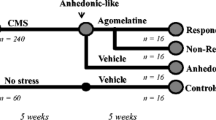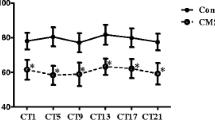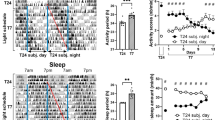Abstract
Background
Depression is associated with circadian disturbances in which melanopsin was a key mechanism. Further studies have demonstrated that melanopsin gene variations are associated with some depressive disorders and aberrant light can impair mood through melanopsin-expressing retinal ganglion cells (mRGCs). The goal of this study was to explore the direct relationship between depression and melanopsin.
Methods
Adult C57BL/6 male mice were physically restrained for 16 h in a 50-ml polypropylene centrifuge tube and all behavioral tests were performed after CRS treatment. Western blot analysis and immunofluorescence were used to detect melanopsin expression in the retina of C57BL/6 mice. And we observed the change of the electrophysiological function and release of glutamate of mRGCs.
Results
The melanopsin expression upregulate in mRGCs of chronic restraint stress (CRS)-treating mice which exhibit depression-like behavior. The frequency of blue light-induced action potentials and light-induced glutamate release mediated by melanopsin also increase significantly. This change of melanopsin is mediated by the CRS-induced glucocorticoid.
Conclusions
CRS may induce the depression-like behavior in mice via glucocorticoid-melanopsin pathway. Our findings provide a novel mechanistic link between CRS-induced depression and melanopsin in mice.




Similar content being viewed by others
References
Albert KM, Newhouse PA (2019) Estrogen, stress, and depression: cognitive and biological interactions. Annu Rev Clin Psychol 15:399–423
An K et al (2020) A circadian rhythm-gated subcortical pathway for nighttime-light-induced depressive-like behaviors in mice. Nat Neurosci 23(7):869–880
Andrus BM et al (2012) Gene expression patterns in the hippocampus and amygdala of endogenous depression and chronic stress models. Mol Psychiatry 17(1):49–61
Aranda ML, Schmidt TM (2021) Diversity of intrinsically photosensitive retinal ganglion cells: circuits and functions. Cell Mol Life Sci 78(3):889–907
Barres BA, Silverstein BE, Corey DP, Chun LL (1988) Immunological, morphological, and electrophysiological variation among retinal ganglion cells purified by panning. Neuron 1(9):791–803
Biello SM et al (2018) Alterations in glutamatergic signaling contribute to the decline of circadian photoentrainment in aged mice. Neurobiol Aging 66:75–84
Bilu C et al (2019) Red white and blue - bright light effects in a diurnal rodent model for seasonal affective disorder. Chronobiol Int 36(7):919–926
Bogen S et al (2013) Morning light therapy for juvenile depression and severe mood dysregulation: study protocol for a randomized controlled trial. Trials 14:178
Boudard DL et al (2009) Loss of photic entrainment at low illuminances in rats with acute photoreceptor degeneration. Eur J Neurosci 30(8):1527–1536
Cheng Y et al (2016) Stress-induced neuroinflammation is mediated by GSK3-dependent TLR4 signaling that promotes susceptibility to depression-like behavior. Brain Behav Immun 53:207–222
Christiansen SL, Bouzinova EV, Fahrenkrug J, Wiborg O (2016) Altered expression pattern of clock genes in a rat model of depression. Int J Neuropsychopharmacol 19(11):pyw061
Dkhissi-Benyahya O et al (2013) The absence of melanopsin alters retinal clock function and dopamine regulation by light. Cell Mol Life Sci 70(18):3435–3447
Duda M et al (2020) Melanopsin: from a small molecule to brain functions. Neurosci Biobehav Rev 113:190–203
Ferrarelli LK (2017) Why pain and stress lead to depression. Science 355(6331):1277–1278
Gompf HS, Fuller PM, Hattar S, Saper CB, Lu J (2015) Impaired circadian photosensitivity in mice lacking glutamate transmission from retinal melanopsin cells. J Biol Rhythms 30(1):35–41
Gonzalez Fleitas MF et al (2021) Melatonin prevents non-image-forming visual system alterations induced by experimental glaucoma in rats. Mol Neurobiol 58(8):3653–3664
Hartwick AT et al (2007) Light-evoked calcium responses of isolated melanopsin-expressing retinal ganglion cells. J Neurosci 27(49):13468–13480
Huang L et al (2019) A visual circuit related to habenula underlies the antidepressive effects of light therapy. Neuron 102(1):128-142e128
Kokras N, Krokida S, Varoudaki TZ, Dalla C (2021) Do corticosterone levels predict female depressive-like behavior in rodents? J Neurosci Res 99(1):324–331
Landgraf D, McCarthy MJ, Welsh DK (2014) The role of the circadian clock in animal models of mood disorders. Behav Neurosci 128(3):344–359
Lax P, Ortuno-Lizaran I, Maneu V, Vidal-Sanz M, Cuenca N (2019) Photosensitive melanopsin-containing retinal ganglion cells in health and disease: implications for circadian rhythms. Int J Mol Sci 20(13):3164
Lazzerini Ospri L, Prusky G, Hattar S (2017) Mood, the circadian system, and melanopsin retinal ganglion cells. Annu Rev Neurosci 40:539–556
LeGates TA et al (2012) Aberrant light directly impairs mood and learning through melanopsin-expressing neurons. Nature 491(7425):594–598
Madiha S, Haider S (2019) Curcumin restores rotenone induced depressive-like symptoms in animal model of neurotoxicity: assessment by social interaction test and sucrose preference test. Metab Brain Dis 34(1):297–308
Maruani J, Geoffroy PA (2019) Bright light as a personalized precision treatment of mood disorders. Front Psychiatry 10:85
Meesters Y, Winthorst WH, Duijzer WB, Hommes V (2016) The effects of low-intensity narrow-band blue-light treatment compared to bright white-light treatment in sub-syndromal seasonal affective disorder. BMC Psychiatry 16:27
Meesters Y, Duijzer WB, Hommes V (2018) The effects of low-intensity narrow-band blue-light treatment compared to bright white-light treatment in seasonal affective disorder. J Affect Disord 232:48–51
Mendoza J (2019) Circadian insights into the biology of depression: symptoms, treatments and animal models. Behav Brain Res 376:112186
Mondin TC et al (2017) Mood disorders and biological rhythms in young adults: a large population-based study. J Psychiatr Res 84:98–104
Mure LS et al (2016) Melanopsin-encoded response properties of intrinsically photosensitive retinal ganglion cells. Neuron 90(5):1016–1027
Nasir-Ahmad S, Lee SCS, Martin PR, Grunert U (2019) Melanopsin-expressing ganglion cells in human retina: morphology, distribution, and synaptic connections. J Comp Neurol 527(1):312–327
Neigh GN, Nemeroff CB (2006) Reduced glucocorticoid receptors: consequence or cause of depression? Trends Endocrinol Metab 17(4):124–125
Nicholls DG, Sihra TS, Sanchez-Prieto J (1987) Calcium-dependent and -independent release of glutamate from synaptosomes monitored by continuous fluorometry. J Neurochem 49(1):50–57
Oh YS et al (2013) SMARCA3, a chromatin-remodeling factor, is required for p11-dependent antidepressant action. Cell 152(4):831–843
Perrin AJ, Horowitz MA, Roelofs J, Zunszain PA, Pariante CM (2019) Glucocorticoid resistance: is it a requisite for increased cytokine production in depression? A systematic review and meta-analysis. Front Psychiatry 10:423
Qin D et al (2019) Chronic glucocorticoid exposure induces depression-like phenotype in rhesus macaque (Macaca mulatta). Front Neurosci 13:188
Roecklein KA et al (2012) Melanopsin gene variations interact with season to predict sleep onset and chronotype. Chronobiol Int 29(8):1036–1047
Roecklein KA et al (2021) Melanopsin-driven pupil response in summer and winter in unipolar seasonal affective disorder. J Affect Disord 291:93–101
Schmidt TM, Kofuji P (2009) Functional and morphological differences among intrinsically photosensitive retinal ganglion cells. J Neurosci 29(2):476–482
Schmidt TM, Taniguchi K, Kofuji P (2008) Intrinsic and extrinsic light responses in melanopsin-expressing ganglion cells during mouse development. J Neurophysiol 100(1):371–384
Schuler KL et al (2017) Diurnal cortisol interacts with stressful events to prospectively predict depressive symptoms in adolescent girls. J Adolesc Health 61(6):767–772
Seo JS et al (2017) Cellular and molecular basis for stress-induced depression. Mol Psychiatry 22(10):1440–1447
Strong RE et al (2009) Narrow-band blue-light treatment of seasonal affective disorder in adults and the influence of additional nonseasonal symptoms. Depress Anxiety 26(3):273–278
Suzuki M et al (2018) Stressful events and coping strategies associated with symptoms of depression: a Japanese general population survey. J Affect Disord 238:482–488
Terman M, Terman JS (2005) Light therapy for seasonal and nonseasonal depression: efficacy, protocol, safety, and side effects. CNS Spectr 10(8):647–663 (quiz 672)
Vandewalle G et al (2011) Abnormal hypothalamic response to light in seasonal affective disorder. Biol Psychiatry 70(10):954–961
Vrshek-Schallhorn S et al (2014) Refining the candidate environment: interpersonal stress, the serotonin transporter polymorphism, and gene-environment interactions in major depression. Clin Psychol Sci 2(3):235–248
Wyrwoll CS, Holmes MC (2012) Prenatal excess glucocorticoid exposure and adult affective disorders: a role for serotonergic and catecholamine pathways. Neuroendocrinology 95(1):47–55
Xie X et al (2019) Depression caused by long-term stress regulates premature aging and is possibly associated with disruption of circadian rhythms in mice. Physiol Behav 199:100–110
Zheng C, Zhang T (2013) Alteration of phase-phase coupling between theta and gamma rhythms in a depression-model of rats. Cogn Neurodyn 7(2):167–172
Zhou WJ et al (2016) The antidepressant roles of Wnt2 and Wnt3 in stress-induced depression-like behaviors. Transl Psychiatry 6(9):e892
Funding
This work was supported by the Natural Science Foundation of Shanghai (20ZR1448400, 21ZR1455100 and 22ZR1453900), Science and Technology Innovation 2030-Major Project (2021ZD0203501 to Jiamin Xu), Shanghai “Science and Technology Innovation Action Plan” medical innovation research (21Y11905600), and the National Nature Science Foundation of China (81371491).
Author information
Authors and Affiliations
Corresponding authors
Ethics declarations
Conflict of interest
The authors declare no competing interests.
Additional information
Publisher's note
Springer Nature remains neutral with regard to jurisdictional claims in published maps and institutional affiliations.
Rights and permissions
Springer Nature or its licensor (e.g. a society or other partner) holds exclusive rights to this article under a publishing agreement with the author(s) or other rightsholder(s); author self-archiving of the accepted manuscript version of this article is solely governed by the terms of such publishing agreement and applicable law.
About this article
Cite this article
Fu, Y., Liu, S., Dong, Y. et al. Chronic restraint stress–induced depression-like behavior is mediated by upregulation of melanopsin expression in C57BL/6 mice retina. Psychopharmacology 240, 283–293 (2023). https://doi.org/10.1007/s00213-022-06302-6
Received:
Accepted:
Published:
Issue Date:
DOI: https://doi.org/10.1007/s00213-022-06302-6




